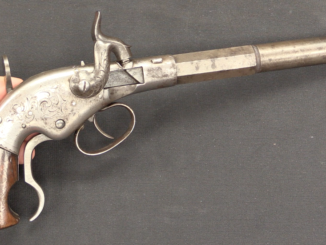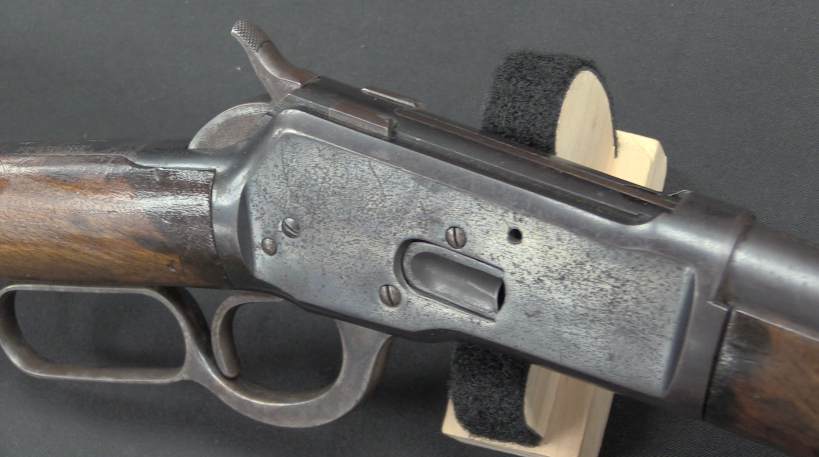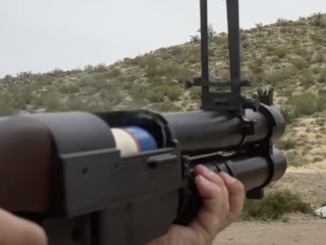On October 1, 1928, the US War Department published a request for semiautomatic rifle designs. The Colt company submitted this .276 caliber rifle to the ensuing trials in 1929. It was designed by Jonathan Edward “Ed” Browning (half brother of John Moses Browning) and was a recoil-operated, tilting bolt design weighing 9lb 9oz and using 108 parts. The tilting bolt system was derived from the 1911 pistol system as designed by John Moses Browning, and the operating system also used an accelerator reminiscent of JMB’s Model 1917 and 1919 machine guns.
After the trials, the Colt 1929 rifle was deemed unfit for further testing by the Ordnance Department because of poor feeding, poor cooling ability, an overly long receiver and short barrel, too many parts, and being too heavy overall. Ed Browning would take the design back to his workshop and continue working on it, eventually replacing the short recoil operating system with an annular gas piston, and bringing it to the Winchester company in the late 1930s.
Today, this rifle resides in the collection of the Cody Firearms Museum.




FYI: Ed Browning’s name was short for Edmund, not Edward.
Thanks. That’s the kind of content I come here for. I’d read accounts of that trials many times and the Colt rifle is always mentioned of being eliminated early but this is the first account or images of the rifle I’ve ever seen.
This does seem like one of the more complicated self-loaders. On the other hand, many of the complications might have been engineered out over the course of multiple design iterations, the fundamental system (short-recoil, titling-bolt) being not necessarily too complex for the job, especially if the the accelerator could be factored out.
“fundamental system (short-recoil, titling-bolt”
Example of SHORT-RECOIL/TILT weapon is Fyodorov Avtomat.
“This does seem like one of the more complicated self-loaders.”
I think that BAR 1918 might be used as starting point to get .276 self-loading rifle with better results.
Generally short-recoil is not the best solution for full-power cartridge self-loading rifle, as barrel need “road” to move which mean that fixed barrel rifle might be lighter assuming same barrel mass, cartridge and furniture mass. Also moving barrel might negative affect accuracy, especially if tolerances are quite big to provide reliable functioning.
Duh. This is why the Germans did not take recoil-operated rifles seriously (probably after Paul Mauser LOST his right eye to a prototype).
If I’m wrong, SAY SOMETHING!!!!!!
“after Paul Mauser LOST his right eye to a prototype”
Rather not, whatever such serious malfunction is possible/not possible is defined by particular weapon design, not belonging or not belonging to general group.
“recoil-operated”
It was not totally abandoned. For example experimental Gustloff-Werke Model 1941 AT rifle (crafted as a part of «Panzerbüchse 243» programme) was recoil-operated (barrel travel 186mm, cartridge: 15×96 from MG 151):
http://weaponland.ru/load/protivotankovoe_ruzhe_gustloff_werke_model_1941/137-1-0-829
Why does the design need an accelerator in the first place?
I can only assume that the accelerator is there for the same reason that it’s on the various Browning machine gun designs. To accelerate the bolt to the rear after unlocking and to coordinate the movement of the locking mechanism parts.
Accelerators work partly to decelerate the barrel, rather than just having it bang against a stop or a stiff spring
and, they transfer some of the momentum from the barrel to the bolt in order to help with extraction and to ensure that the bolt has sufficient momentum to complete the cycle.
Accelerators are implicit in the toggle lock actions used in many of the successful early short recoil operated guns such as the Maxim based machineguns (including the Vickers), the Furrer line of automatics and the Borchardt and Borchardt Luger pistols.
In MG use, an accelerator is an important componant in a recoil operated gun, as there is usually a belt feed to power, so any recoil that is available (plus some gas assistance from a muzzle “recoil” intensifier is harnessed.
The people who developed short recoil operated machine guns which didn’t incorporate toggle mechanisms, Such as JM Browning and AJ Lahti, often incorporated a lever type accellerator.
one small part of the brilliance of the Browning combined slide and breech bolt in short recoil operated pistols, is that it is by far the heaviest of the recoiling parts and it continues moving for the full cycle. The barrel is so light that it isn’t worth capturing its momentum during un locking.
I know about the function of an accelerator in full-auto short recoil weapons, but apart from toggle lock actions they seem to be rare in semi-auto guns. The Lahti L-35 pistol had an accelerator for a specific reason (that is, reliability in cold weather), but I wonder why Ed Browning put one in this design.
I agree with your assessment of accelerator function – it is right on. The toggle locks posses some accelerating effect, but by far not as much as straight accelerator.
In my view, the function of accelerator (or “momentum convertor” if you will) had not been so far fully exploited. the benefit is obvious – absence of gas cylinder and need for extensive maintenance. This is one of my long term pre-occupations part of advanced priming.
“absence of gas cylinder and need for extensive maintenance”
If you do (or your client) do not want gas cylinder for some reason then why not to use delayed-blowback principle as in Schwarzlose machine gun?
I will try to tackle you question as well and as frankly as I can. First, there is a theory and second there is practical experience; they seem to support each other. In theory, you can implement delayed blow-back of some sort for almost any infantry and small cannon cartridge.
In such case, you are assuming that barrel is stationary at all time while action is held for necessary period of time in battery (or resisted to move instantly). This is certainly possible, but it entails a narrow functional/operating zone. What that means is consistently machined/ heat treated parts working at near to perfect clean/ lubricated/ wear condition and closely specified ammo. It will not work always to satisfaction since this balance is tough to achieve. There are penalties to pay – one vivid sample being FAMAS (ruptured cases). The same working principle worked fine in .30 carbine calibre. There is also good reason why HK33 and derivatives were pulled out of service.
With short recoiling barrel you have gradual and controlled separation of action from barrel (while they both move at varying speed) giving you better chance for control of cartridge wall support vs. pressure in time. Also, it appreciably improves conditions for safe and reliable extraction.
Not to be fooled however, there is ALWAYS some degree maintenance required, pending a particular design. For one, chamber and bore being the essential element are due for cleaning in time of need. The part of residue intrusion however, as is in case of gas operation is removed and that may be a plausible factor above all.
The reason why you see prevalence of gas operated systems is that it is virtually foolproof and will work at almost any conditions (with some better than with others). The obvious disadvantage, part of due periodic cleaning is dynamic effect to shooter’s shoulder which works AGAINST intended ability to hit target at second correction shot.
“second correction shot”
If you want more accurate 2nd shot AND gas-operated, it was done: see AN-94
http://world.guns.ru/assault/rus/an-94-abakan-e.html
I am aware of that design just short of firing it. It basically encapsulates my way of thinking (such as lockup not mated solid into frame) but it ended up on little too complex side and this is its disadvantage AFAIK.
I do not intend to analyse it here but it is commonly perceived as G11 on conventional ammo and I think that is fair assessment. Neither one found real world application.
Relative to ability of firing follow up shot, I had short intro into FAMAS. That thing is as close as it gets in terms of stability on shoulder; no sense of kick whatever. One strange sense I had though (and I read same observation by others) is that it forces your hear straight up. But that should not be a problem if you know how to shoot fast before other side gets you.
“Neither one found real world application.”
AN-94 was adopted – it does NOT replace EVERY AK74 in Russian service. It has some flaws but there is only accuracy enhancing design AEK-971
http://world.guns.ru/assault/rus/aek-971-e.html
which is better than AN-94 unless you consider ONLY 2nd shot accuracy.
Daweo, it is not about “accuracy”; that’s different subject. It is about ability to self-recover from line of aim or even better, not to deviate al all. None of them can do this to full extent.
All designs I have seen so far are at best replacement solutions, not taking on the subject at the core. Sure, muzzle break is an ‘easy’ fix, but for a nasty cost.
Cheers!
For clearing of terms look at this blog. It is aimed toward CNC and robotics, but the terms are generally applicable. There is very nice illustration using sample of marksmanship.
http://paladintechworks.com/index.php/home/blog/12-tech/14-understanding-the-terms-precision-repeatability-and-accuracy-in-the-cnc-world
In guns, if you take away personal shooter’s part you end up with REPEATABILITY (assuming it is held in clamp for a moment) – that is key ballistic barrel capability; meaning consistency from shot to shot. Rest involves operator. It would be easier without him.
The term of “deviation due to weapon/barrel movement” is separate phenomenon and it is cause not just by recoil force but by combat stress, breathing, sudden body motion and so on. It gets more complex, more you think about it.
Good luck with getting the rifle to work. It’s just too complicated for the ordinary infantryman to fix while under a barrage of bullets and artillery. I suspect part of this prototype made it into the M1 carbine…
It’s interesting that the bolt face appears to be set up for controlled feed with the case rims sliding under the extractor.
Controlled feed systems are much more difficult to get to feed correctly than the push feed.
The Garand (and IIRC the pedersen) were push feed, with the extractor snapping over the rim at the final stage.
I wonder whether that nice little touch, caused Browning and Colt some extra difficulties with reliability?
You may be right. The extractor should not be involved with process of feeding. It is just another addition to already precarious act.
Accelerator in this rifle seems double purposed. First, to keep the barrel in recoiled back position to wait the breechbolt’s reciprocal movement during ejecting and reloading, and using only one recoil spring for this purpose, and second, to give more speed for breechbolt and slower speed for barrel and its attachments during recoil.
Some little search at Browning Patent 1628 226 relating accelerator using machinegun at its text, paraghraph 70, shows and also states that, the accelerator functions as double purposes as locking the barrel and its attachments at recoiled back position. In this particular rifle, it seems, the purpose of using an accelerator balanced rather to this secondary aim.
Accelerator on M1919 .30cal is not to lock the breech. For that there is dedicated vertically sliding block. Take a look at diagram on left from accelerator (also in blue) – that’s the lock.
http://browningmgs.com/
Thanks for clarification. The term “lock” especially used to match with the statement of page 10, paraghraph 70 and points out the secondary mission of accelerator as temporarily holding the barrel and its engagements at recoiled back position until joining with the breechbolt at beginning of battery on situation which I wanted to point out the similarity of function of accerelator used in this experimental rifle.
However, glad to draw your attention to this alternative of accerelator mission with this respect.
Sorry, forgot to add…This is the link; http://www.freepatentsonline.com/1628226.pdf
Sorry, forgot to add. This is the link;
http://www.freepatentsonline.com/1628226.pdf
Yeah, it might be “temporary holding” barrel extension when fully recoiled. In any case that gun was extensively complex and fancy. Every time barrel got changed the headspace had to be checked and adjusted. But overall it was a progress in comparison to Maxim/ Vickers.
Interesting, he did not apply for patent until 4 years after introducing it into service. Be it today, there would be tons of copycats. People were probably more honest then.
Denny,
“People were probably more honest then.”
This made me laugh out loud! ^__^
No, this is just one of many patents that cover Browning’s short-recoil operated machine guns with their many features, variants, and improvements.
What interesting and even funny in this patent is, neither of 77 claims of its containt states anything about the accelarator and its double purposed mission and its momentum converting feature. It seems, in the text only, the accelerator is provided only to give speed for breechblock and to keep the barrel extention at recoiled back position during ejection and relaoading. No statements about its slowing down feature at the barrel extention and its attachments and its possible aid to the heavy shock absorber provided for cushioning the impact of heavy barrel extention and its parts. It seems, some approaches like momentum convertion were understood afterwards even it was partly stated in earlier registrations like Pal Dedai Kiraly’s 1913 dated 1073808 No. Patent.
@Strongarm
I am not familiar with contents previous patents (as Brian is hinting); it is possible that the function of this item (being accelerator) had been covered in previous patents. The 1919 model had its predecessor and this is an “upgraded” model. My familiarity (although aging) is primarily with latter.
PS: I hope you keep safe with respect to recent and ongoing events. Take care!
Thanks Denny. We all have been trying to keep ourselves safe at ongoing tragicomic events.
It is very good to see this design which is rare case of use of accelerator. I am actually quite impressed with it.
I do not feel exactly comfortable in position to offer critique, but since I had been involved with conceptual design of recoil operated firearms, perhaps offer that much:
– guidance of barrel is not very efficient since it uses lots of extra material and space in addition of being mentioned impediment to cooling. There were some better barrel guidance systems shown on this web.
– the accelerator, to be truly of maximum benefit needs to be attached not to barrel extension, but to receiver. That will produce two benefits – it will shorten receiver (as mentioned) and it will improve dynamic effect (transfer of momentum).
There is no fee asked for this advice; after all it is unlikely someone will attempt to replicate this design with suggested improvements :=)
To add to note about accelerator.
I realize this is close transfer from Browning 1919 MG and it was apparently deemed suitable for this application; once it worked in first case, why not in second – seem to be fair presumption.
On 1919 MG the effect of mentioned accelerator in slowing down primary recoiling mass is substantial to the degree, that for achieving reliable function muzzle booster was added. There were several versions of it.
Machining and fitting one of these must have been a nightmare, but it’s cool to see. Thanks!
Jonathan Edmund Browning patent – US1801072 🙂 Priority date – 19.03.1928
Thanks Nikolay, Accelerator functions are clearly stated in this patent text and even relating its momentum converting feature as slowing the barrel extention speed.
Patent also contains claims(roughly from 15 to 22) covering the descriptions and functions of the accelerator which should be the base of the usage aftermath.
I am glad you found your answers!
Thanks Denny. As far as I understood from a rough research over the related patents, “Multi Purpose Accelerator Usage” was a novel invention belonging to Jonathan Edmund Browning, but permitted to use in earlier machineguns designed by John Moses Browning through the restriction of giving no place in any of the claims of the possible registered patents. It seems, Mr Edmund did not let the invention in unidentified form and used in that rifle patent with the clear claims which dated after Mr Moses’s machinegun patent.
It is also interesting that, “Momentum Converting” feature of the accelerator, though took place within the patent text, was not stated as an approach, but descibed as if, “transmitting the gained energy through the barrel extention to the breechblock in a more prolonged time interval and thereby, resulting to be exhausted” form.
May be interesting for you.